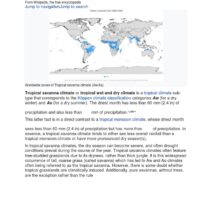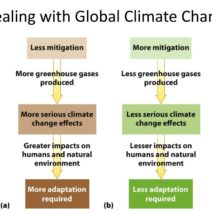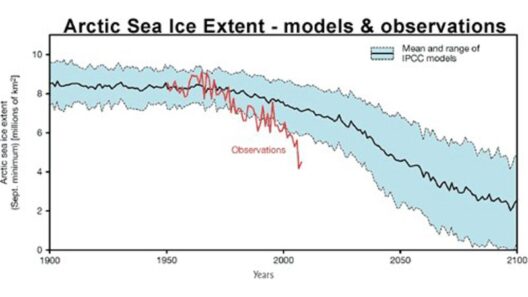The discourse surrounding global warming often elicits fervent debate, particularly concerning the various factors that could contribute to this pressing phenomenon. Among these factors, solar activity is a subject of investigation due to its potential influence on Earth’s climate. Scientists have long scrutinized the Sun’s role in driving changes in temperature patterns, and the discussion has evolved as our understanding of solar dynamics has matured. This exploration endeavors to elucidate whether fluctuations in solar activity may indeed be a significant driver of global warming.
To accurately assess the Sun’s impact, it is essential to comprehend the mechanisms through which solar radiation affects climate. The Sun emits energy in the form of electromagnetic radiation, which reaches Earth and warms the planet. This solar energy is crucial for supporting life, but variations in its intensity can provoke climatic shifts. The primary types of solar activity that warrant scrutiny include sunspots, solar flares, and solar cycles. Each of these phenomena possesses unique characteristics that can influence atmospheric conditions.
Sunspots are temporary phenomena on the solar surface that appear as dark patches. They are fundamentally cooler regions, formed by magnetic activity, yet they are indicative of increased solar output when their numbers rise. A correlation exists between sunspot cycles and the Earth’s temperature: during periods of high sunspot activity, temperatures can rise, suggesting a potential link between solar irradiance and climate. However, this relationship is complex and influenced by numerous variables, rendering it an area ripe for ongoing research.
Solar flares, another aspect of sun activity, involve intense bursts of radiation that can significantly impact space weather. They can have repercussions on Earth’s atmosphere and, in certain instances, influence climate patterns. The most profound effects arise from coronal mass ejections (CMEs)—large expulsions of plasma and magnetic fields from the Sun’s corona. While there is some evidence suggesting that geomagnetic storms induced by solar flares can affect local weather systems, the broader implications for climate change remain elusive.
The solar cycle, which spans approximately 11 years, manifests alternating periods of solar maximum and minimum activity. During solar maximum, an increase in sunspots and solar flares occurs. Conversely, during solar minimum, solar output diminishes. Some researchers posit that these predictable cycles may have periodic effects on global temperatures. Nevertheless, the magnitude of influence exerted by solar cycles compared to anthropogenic factors, such as greenhouse gas emissions, has become a pivotal consideration in this debate.
Critics of the solar activity hypothesis often argue that while the Sun plays a fundamental role in Earth’s climate system, the contributions of human activity are more pronounced. The burning of fossil fuels has been identified as the primary driver of recent climate change, releasing exorbitant quantities of carbon dioxide and other greenhouse gases into the atmosphere, which trap heat. The Intergovernmental Panel on Climate Change (IPCC) consistently emphasizes that the increase in global average temperatures, particularly over the last century, cannot be solely attributed to natural factors, including solar activity.
Counterarguments advocating for the significance of solar activity cite historical climate trends, linking periods of heightened solar output to warmer climatic phases, such as the Medieval Warm Period and the Roman Warm Period. These instances illustrate that natural climate variability has played a noteworthy role. Additionally, exploring paleoclimate data from ice cores and tree rings reveals that solar cycles have influenced long-term climate shifts, providing context for understanding contemporary shifts in temperature.
It is also prudent to consider that the interplay between solar activity and Earth’s climate is multifaceted, involving complex feedback mechanisms. For instance, the Earth’s atmosphere has evolved and adapted to previous variations in solar activity. Increased solar output may trigger feedbacks within the climate system that amplify or attenuate warming effects. Furthermore, external factors, such as volcanic eruptions, can interact with solar influences, complicating the delineation of cause and effect.
As research progresses, technological advancements enable more sophisticated analyses of solar impacts. High-resolution satellite data now allow for the meticulous tracking of solar radiation and its variation over time. This enhanced understanding is crucial in accurately modeling future climate scenarios. Despite ongoing investigations, some uncertainties persist; thus, it remains critical for the scientific community to rigorously analyze solar activity alongside other variables contributing to global warming.
Fostering awareness regarding the nuanced role of solar activity in climate change is vital. Misconceptions can lead to a disproportionate emphasis on solar influences while neglecting the predominant impact of human-induced factors. Accordingly, an integrated approach that underscores the synergy between natural and anthropogenic influences can foster a more comprehensive understanding of climate dynamics.
In conclusion, the relationship between solar activity and global warming is intricate and warrants continued examination. While fluctuations in solar output, including sunspots and solar cycles, undoubtedly affect climate, the prevailing consensus indicates that anthropogenic factors are currently the primary drivers of observed global temperature increases. Through continued research, enhanced understanding, and dissemination of information, society can be better equipped to tackle the challenges posed by climate change, with a balanced perspective on the role of solar activity within the broader climate system.







